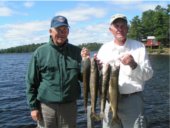

| Members Showcase |
 |
Contact Us:
contact@ffsportsmensclub.com
Community Links
www.perchlakebass.com
www.canadianbass.com
www.rainylakesports.com
New live-release system cuts bass mortality
The Fort Frances Canadian Bass Championship puts just as much stock in the live release of tournament fish as anglers do in catching them.
To ensure smallmouth bass are returned to the lake with the best possible care, an intricate system backstage at the annual tournament is carried out by dedicated volunteers headed by the Fort Frances Sportsmen’s Club.
This year saw only 23 bass die (out of 1,510) prior to release, whereas last year saw 83 deaths (out of 1,928 caught).
That was the lowest total since 2001, with a large part of that improvement credited to the new-and-improved livewell system backstage.
“We have a new system that provides total water circulation directly from the Rainy River,” club member Jeff Johnstone told www.fortfrances.tv during the tournament.
“The idea is to keep the oxygen level up and the temperature down to allow the fish to be released in the best possible conditions,” he explained.
Anglers also do their part, ensuring fish are kept healthy in each boat’s livewells. They also are given maps during the rules meeting prior to the tournament to keep track of where their fish are caught.
After being weighed on stage, the fish immediately are passed on to the volunteers, who then place them in holding tanks.
Periodically during the weigh-ins, the fish are brought to a live-release boat—with a large livewell attached to the back of it—which then takes the fish to an area near where they originally were caught.
Bass are known to go to great lengths and great effort to return to their territory, so this offers them the greatest opportunity to do so.
Trying to return home—combined with the obvious additional stress of being caught and weighed—could prove to be too much for a bass to survive unless these steps are taken.
Before they are released, some 400 bass also are sampled by MNR area biologist Darryl McLeod, which helps keep track of the fish’s longevity and growth.
“The main purpose is to track the health of the smallmouth bass population in Rainy Lake,” McLeod noted.
“[We] clip the fourth dorsal spine from the fish and it goes to our aging lab in Dryden, where we section that dorsal spine to find the age of the fish,” he explained.